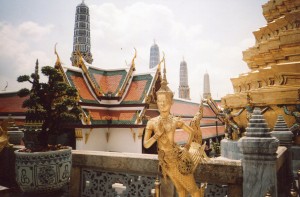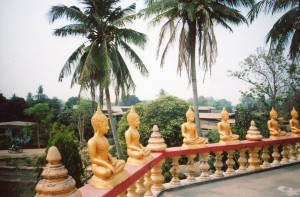I entered Thailand after exploring Khmer temples in Cambodia. Its art is some of the most enchanting I’ve ever seen, and some of the most under-appreciated in the world.
Thais avoid building monuments, like Angkor Wat, that thrust hugge walls in your face. Instead of trying to overwhelm you, they enchant with an endless variety of graceful forms and cheerful colors.
But Thai art also often masks animistic fears and social pressures–things in Thailand often have many meanings beneath the surface decorum. These tensions between delicacy and danger have inspired an infinite amount of cultural wealth that most visitors miss.
The Khmers ruled more than half of Thailand from the 11th to the 13th century, but when Thais gained independence, magic began to happen. The monumental and symmetrical forms that Cambodians emphasized were made more flowing and sinuous. Thais mixed art forms from India, Burma, Malaysia, Cambodia, Yunnan, and earlier cultures on their land, like the Dvaravati and Mon. Thais blended all of these with their own heritage from southern China (they lived there before migrating south in the 13th century, and blending with the local Mon people) of living in small communities in rivers and harmonizing themselves with nature and ancestral spirits.
Thai art blends with a natural landscape that varies from teak forested mountains, to fertile river planes that comprise the people’s rice bowl, to sparkling oceans. This land is blessed with a dazzling variety of trees, flowers, birds, fruits and mixtures of human ethnicity.
This natural and artistic abundance meshed in a chemistry that created endless cultural forms that emphasize grace, fun and the human scale. Exploring them was one of the happiest months of my life. I’ll share my discoveries with you in future posts.



Comments on this entry are closed.